Paper money is what keeps any country running, and the RMB, or yuan, is the currency of China. In many countries, paper currency is not only practical, but also features well-known public figures and landmarks. For example, you can see the White House on the back of the US 20-dollar bill and the United States Capitol on the back of the US 50-dollar bill. So, what is shown on the back of China’s bills? Do you know?
China’s paper money is currently in its fifth series of production, and there are presently six denominations: 100 yuan, 50 yuan, 20 yuan, 10 yuan, 5 yuan, and 1 yuan. Are you familiar with all of them?
1. The image on the 100-yuan RMB: “人民大会堂(rénmíndàhuìtáng) the Great Hall of the People”
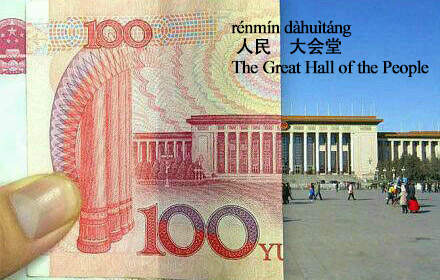
Those who have come to Beijing must have visited Tian’anmen Square; the Great Hall of the People is located on the west side of the square.
Built on September 24, 1959, the Great Hall of the People was designed to celebrate the tenth anniversary of the nation. The architectural style of the building looks like the Chinese character “山(shān) mountain.” With its total area reaching 171,800 square meters, which is larger than that of the Forbidden City, it claims to be the biggest hall in the world. As the Great Hall of the People is printed on the largest denomination of paper money, you can see its great significance to Chinese people.
2. The scene on the 50-yuan RMB: “布达拉宫(bùdálāgōng) The Potala Palace”
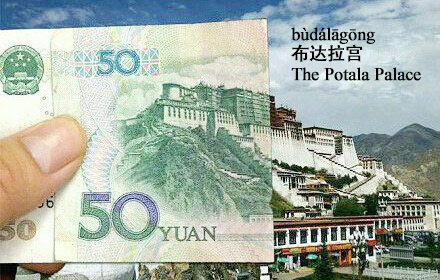
You may have heard of “西藏(xīzàng) Tibet.” Situated in the center of Tibet’s capital, “拉萨(lāsà) Lhasa,” the Potala Palace is said to be the place that is closest to Heaven.
The Potala Palace, also called “a bright pearl inlaid on the roof of the world,” was built 1,300 years ago when the king of the Tubo Dynasty, Songtsan Gampo, married Princess Wencheng from the Tang Dynasty. Now it is the symbol of Lhasa and of the entire Qinghai-Tibet Plateau as well.
This edifice serves as a palace, castle and also temple, with abundant historical relics and handicraft articles collected within. They are precious cultural treasures from China and around the whole world.
3. The scenery on the 20-yuan RMB: “桂林山水(guìlínshānshuǐ) mountains and waters in Guilin”
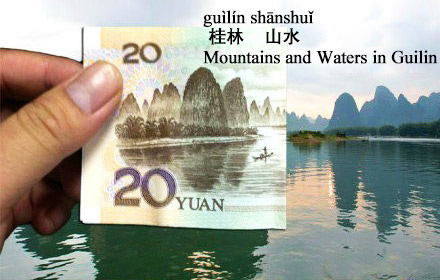
As the saying goes, “桂林山水甲天下(guìlínshānshuǐ jiǎ tiānxià)” — The scenery of Guilin has been called the finest under heaven. Guilin, the national key tourist city and garden city, is located in Guangxi Province in southwest China. You really have to visit this picturesque city if you get the chance .
Imagine boating on the famous “漓江(líjiāng) Lijiang River.” As you enjoy the picturesque gumdrop mountains and scenic beauty along the river, you will feel like you are traveling within a painting. It is really a sight to behold. For a different perspective of this charming scenery, you can also walk along the Lijiang River or go cycling.
4.The image on the 10-yuan RMB: “三峡夔门(sānxiá kuímén) The Kuimen Gate of the Three Gorges”
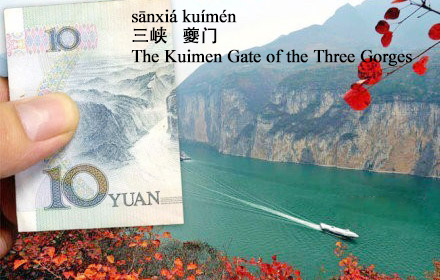
The Kuimen Gate is located in Fengjie County of Chongqing District in southwest China. As you can see from the picture, the Kuimen Gate gets its name from the mountains framing both sides of the river. The mountains rise straight from the ground and are high enough to kiss the clouds. They serve as the natural gate of the western entrance to the Qutang Gorge, the first gorge of the Three Gorges.
The Kuimen Gate is only 8 kilometers long and is also the narrowest part of the Three Gorges, but it is characterized by its marvelous natural beauty and cultural artistic heritage as well.
5. The scenery on the 5-yuan RMB: “泰山(tàishān) Mount Tai”
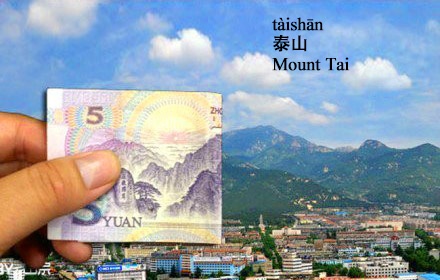
Do you know the “ 五岳(wǔyuè) Five Famous Mountains” of China? Mount Tai, located in “泰安(tài’ān) Taian City” in Shandong Province, and also called “东岳(dōngyuè) the Eastern Mountain,” is the first of these five famous mountains.
Mount Tai has a reputation for its magnificent sceneries such as rolling mountains, green pines, huge rocks, changeable clouds and mist, etc. Its “Four Remarkable Spectacles” are the most famous, including “旭日东升(xùrì dōngshēng)” — the sunrise, “晚霞夕照(wǎnxiá xīzhào)” — the sunset, “泰山佛光(tàishān fóguāng)” — the special sunlight and “云海玉盘(yúnhǎi yùpán)” — the sea of clouds.
6. The scene on the 1-yuan RMB: “三潭印月(sāntányìnyuè) Three Pools Mirror the Moon”
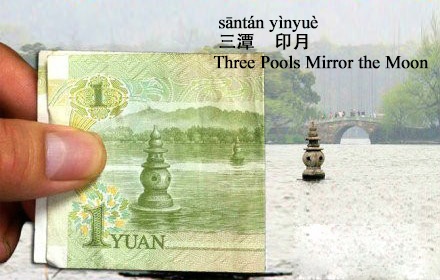
Although it is printed on the smallest denomination of China’s currencies, only 1-yuan RMB, “三潭印月(sāntányìnyuè)” is just as grand as the sceneries above. Actually, “三潭印月(sāntányìnyuè)” is a landmark of “西湖(xīhú) The West Lake” in the center of Hangzhou.
“三潭印月(sāntányìnyuè)” actually refers to the biggest islet in the West Lake. As you can see from the picture, there are three small stone towers in the lake which are the “三潭(sāntán).” On autumn nights, lanterns and candles lit within the small towers, along with the moonlight and their reflections on the water, together create an amazing, gorgeous scene.
So, what do you think of these enchanting scenes? Which is your favorite? If you do get the chance to travel to China and are wondering where to go, heading to the places featured on your money might be a great way to start.

1. Where is “人民大会堂(rénmíndàhuìtáng)”?
A. In Beijing
B. In Shanghai
C. In Guangzhou
2. The famous river in Guilin, Guangxi Province is the .
A. Yangtze River.
B. Lijiang River.
C. Yellow River.
3. What image is shown on the 5-yuan RMB note?
A. 三潭印月(sāntányìnyuè)
B. 泰山(tàishān)
C. 三峡夔门(sānxiá kuímén)




thanks ~ nice to know.